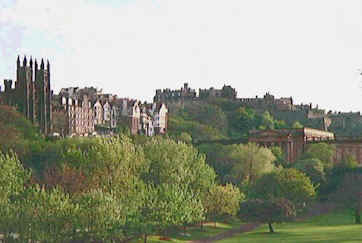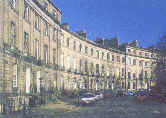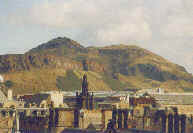 Edinburgh is the capital of Scotland from 1437, lying
close to the southern shore of the Firth of Forth; population (1991) 421,200. The city
grew up round the 11th century. castle built by Malcolm III on a rocky ridge which
dominates the landscape. Edinburgh is the capital of Scotland from 1437, lying
close to the southern shore of the Firth of Forth; population (1991) 421,200. The city
grew up round the 11th century. castle built by Malcolm III on a rocky ridge which
dominates the landscape.The 'Royal Mile', which links the castle with the Palace of
Holyroodhouse at the bottom of the ridge, passes through the old medieval burghs of
Edinburgh and the Canongate. Princes Street, to the north, is the main thoroughfare in the
'New Town' which was built in the 18th and 19th century. It was the birthplace of the
founder of the Bank of France, John Law (1671-1729), the painter Sir Henry Raeburn
(1756-1823), Robert Louis Stevenson (1850-94), and Sir Walter Scott (1771-1832).
Edinburgh has hosted a famous international festival annually since 1947. It is the
headquarters of the Scottish Office, the Forestry Authority, and the British Geological
Survey and home of the University of Edinburgh (1583), Heriot-Watt University (1966), and
Napier University (1992). Finance, brewing, tourism, and light industry are important.
 Edinburgh is the jewel in Scotland's
crown. The jewel has many facets: classical architecture piled on hills, tree-filled
valleys, sweeping Georgian crescents, medieval closes, graceful bridges soaring across
chasms, green parks, sudden views of the sea from street corners. And the castle. That
supreme castle, which looks so right that it might have grown out of the rock by some
natural process. Edinburgh is the jewel in Scotland's
crown. The jewel has many facets: classical architecture piled on hills, tree-filled
valleys, sweeping Georgian crescents, medieval closes, graceful bridges soaring across
chasms, green parks, sudden views of the sea from street corners. And the castle. That
supreme castle, which looks so right that it might have grown out of the rock by some
natural process.
The castle, older than Edinburgh itself, occupies a special corner of the Scottish folk
memory. The fortress on the rock, the palladium of the city, remains a compelling symbol.
It is a perpetual, very public reminder to Scots of their roots.
 It has been said that Edinburgh often
looks less like a modern city than a theatrical backdrop. This is true. On the visual
level, Edinburgh is pure theatre. The basic reason, of course, is that Scotland's capital
has the good fortune to be built upon hills. It has been said that Edinburgh often
looks less like a modern city than a theatrical backdrop. This is true. On the visual
level, Edinburgh is pure theatre. The basic reason, of course, is that Scotland's capital
has the good fortune to be built upon hills.
The local topography is the result of the fact that was the principal volcano in this
region millions of years ago. Much later, glacial action gouged a number of dramatic
valleys in the landscape and shaped the high ridge on which the stands today.
The pedestrian in Edinburgh seldom walks on level ground: his day, like life itself, is
a series of ups and downs. The gradients, however, are seldom steep, and the ideal way to
see Edinburgh is on foot.
Few cities offer more to those with a discerning
eye. (For photographers it is a paradise.) Edinburgh's other great blessing is its
architecture, whether Georgian, Victorian, Scots Baronial, medieval or whatever. Edinburgh
has several thousand buildings that are officially protected because of their
architectural or historic importance -- more than any other city outwith London. A quarter
of Scotland's A-listed buildings are in Edinburgh.
Hot Link-Live
Webcam |